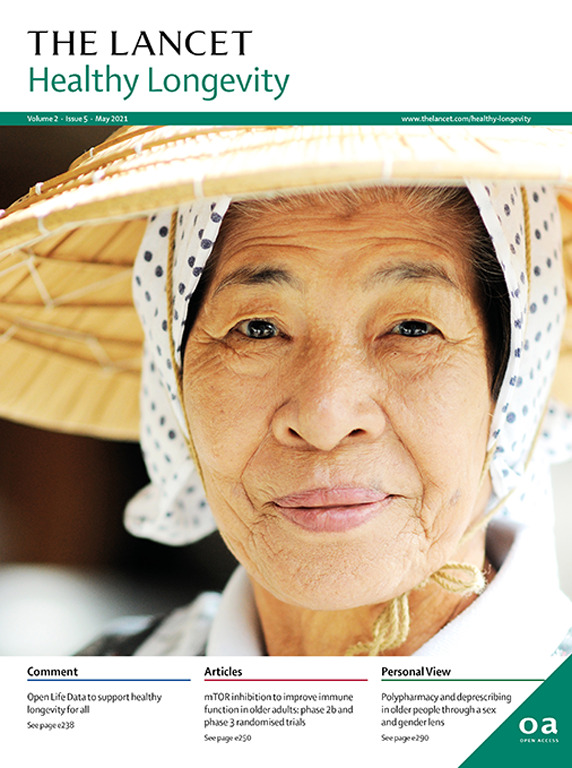电子衰弱指数在英国年轻人和老年人中的适用性:一项基于人群的队列研究。
IF 14.6
Q1 GERIATRICS & GERONTOLOGY
引用次数: 0
摘要
背景:电子衰弱指数(eFI)是在老年人(年龄≥65岁)中开发的。目前在临床实践中还没有针对年轻人(18-64岁)的有效虚弱评分。本研究的目的是研究与老年人相比,年轻人的eFI评分与不良健康结果是否有相似或不同的关联。方法:在这项基于人群的队列研究中,分析了来自英国临床实践研究数据链GOLD数据库的电子健康记录。我们使用了2015年11月30日的患者横截面,这些患者在数据采集前至少在全科诊所注册了2年。患者分为青壮年(18-64岁,n=708 235,女性49.4%)和老年(65-95岁,n=231 819,女性54.3%)。对于所有纳入的患者,计算eFI评分、个体eFI缺陷患病率和eFI虚弱类别。对于主要结局,计算各组1年和3年死亡率和紧急住院率的粗风险比(hr),并与eFI定义的成人进行比较。结果:efi定义的衰弱在老年人中的患病率高于年轻人。在老年人中,231 819人中有77 290人(33.3%)为轻度虚弱,44 523人(19.2%)为中度虚弱,22 572人(9.7%)为重度虚弱。在年轻人中,708 235人中有76 991人(10.9%)为轻度虚弱,12 552人(1.8%)为中度虚弱,2088人(0.3%)为重度虚弱。有轻度、中度和重度虚弱的年轻成人的1年死亡率和1年急诊住院的调整hr大于有相同虚弱分类的老年人。具体而言,与健康老年人相比,轻度虚弱老年人经年龄性别调整后的1年死亡率hr为1.94 (95% CI为1.8 -2·09),中度虚弱老年人为2.99 (95% CI为2.77 - 3.22),重度虚弱老年人为4.03 (95% CI为3.72 - 3.36)。与健康的年轻人相比,年龄性别调整后的1年死亡率hr为轻度虚弱的年轻人3.15(2.80 - 3.55),中度虚弱的年轻人5.88(4.95 - 5.98),严重虚弱的年轻人12.61 (9.76 - 16.30)(Z评分)。解释:与老年人相似,eFI识别出虚弱的年轻人具有高死亡率和急诊住院风险。eFI可能是一种识别个体以进行进一步评估和干预的工具。资助:惠康信托基金和首席科学家办公室。本文章由计算机程序翻译,如有差异,请以英文原文为准。
Applicability of the electronic frailty index in younger and older adults in England: a population-based cohort study
Background
The electronic frailty index (eFI) was developed in older adults (aged ≥65 years). There are currently no validated frailty scores in clinical practice for younger adults (aged 18–64 years). The aim of this study was to examine whether the eFI score in younger adults had similar or different associations with adverse health outcomes compared with older adults.
Methods
In this population-based cohort study, electronic health records from the UK Clinical Practice Research Datalink GOLD database were analysed. We used a cross-section of patients on Nov 30, 2015, who were alive and had been registered with a general practice for at least 2 years before data capture. Patients were stratified into younger adults (aged 18–64 years, n=708 235; 49·4% female) and older adults (aged 65–95 years, n=231 819; 54·3% female). For all included patients, eFI score, prevalence of individual eFI deficits, and eFI frailty category were calculated. For the main outcomes, crude and age–sex adjusted hazard ratios (HRs) were calculated for 1-year and 3-year mortality and emergency hospitalisation for each group compared with adults defined by the eFI as fit.
Findings
The prevalence of eFI-defined frailty was higher in older adults than younger adults. Specifically, in older adults, 77 290 (33·3%) of 231 819 had mild frailty, 44 523 (19·2%) had moderate frailty, and 22 572 (9·7%) had severe frailty. For younger adults, 76 991 (10·9%) of 708 235 had mild frailty, 12 552 (1·8%) had moderate frailty, and 2088 (0·3%) had severe frailty. Adjusted HRs for both 1-year mortality and 1-year emergency hospitalisation in younger adults with mild, moderate, and severe frailty were greater than in older adults with equivalent frailty categorisation. Specifically, compared with fit older adults, age–sex adjusted 1-year mortality HRs were 1·94 (95% CI 1·80–2·09) in older adults with mild frailty, 2·99 (2·77–3·22) with moderate frailty, and 4·03 (3·72–4·36) with severe frailty. Compared with fit younger adults, age–sex adjusted 1-year mortality HRs were 3·15 (2·80–3·55) in younger adults with mild frailty, 5·88 (4·95–6·98) with moderate frailty, and 12·61 (9·76–16·30) with severe frailty (Z score p<0·001 for all comparisons). Compared with fit older adults, age–sex adjusted HRs for 1-year emergency hospitalisation were 2·30 (2·22–2·39) in older adults with mild frailty, 4·09 (3·94–4·25) with moderate frailty, and 6·76 (6·50–7·03) with severe frailty. Compared with fit younger adults, age–sex adjusted HRs for 1-year emergency hospitalisation were 3·16 (3·07–3·25) in younger adults with mild frailty, 6·64 (6·34–6·94) with moderate frailty, and 13·02 (12·04–14·09) with severe frailty (Z score p<0·001 for all comparisons). Similar associations were observed for 3-year mortality and emergency hospitalisation.
Interpretation
Similarly to older adults, the eFI identifies younger adults with frailty at high risk of mortality and emergency hospital admission. The eFI might be a tool to identify individuals for further assessment and intervention.
Funding
Wellcome Trust and Chief Scientist Office.
求助全文
通过发布文献求助,成功后即可免费获取论文全文。
去求助
来源期刊

Lancet Healthy Longevity
GERIATRICS & GERONTOLOGY-
CiteScore
16.30
自引率
2.30%
发文量
192
审稿时长
12 weeks
期刊介绍:
The Lancet Healthy Longevity, a gold open-access journal, focuses on clinically-relevant longevity and healthy aging research. It covers early-stage clinical research on aging mechanisms, epidemiological studies, and societal research on changing populations. The journal includes clinical trials across disciplines, particularly in gerontology and age-specific clinical guidelines. In line with the Lancet family tradition, it advocates for the rights of all to healthy lives, emphasizing original research likely to impact clinical practice or thinking. Clinical and policy reviews also contribute to shaping the discourse in this rapidly growing discipline.
 求助内容:
求助内容: 应助结果提醒方式:
应助结果提醒方式:


